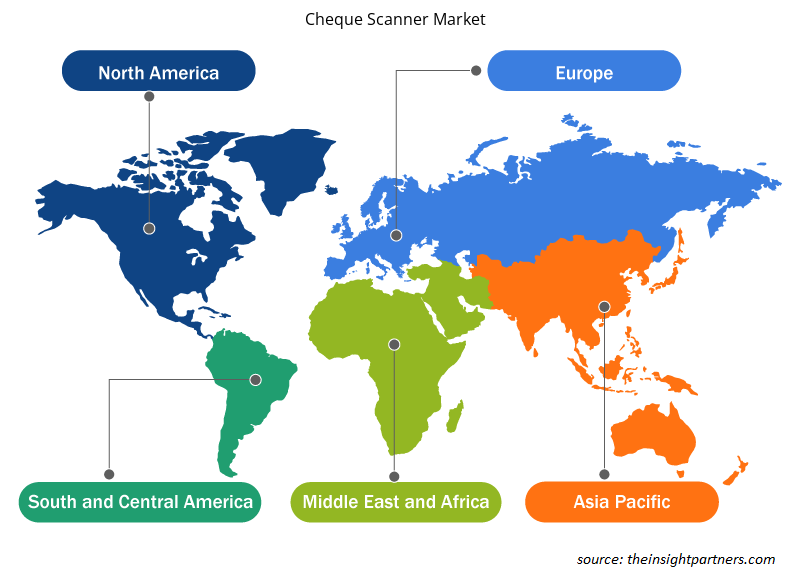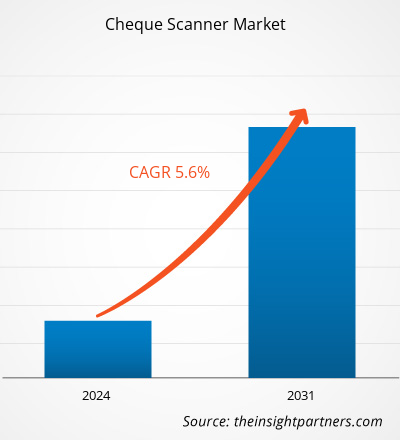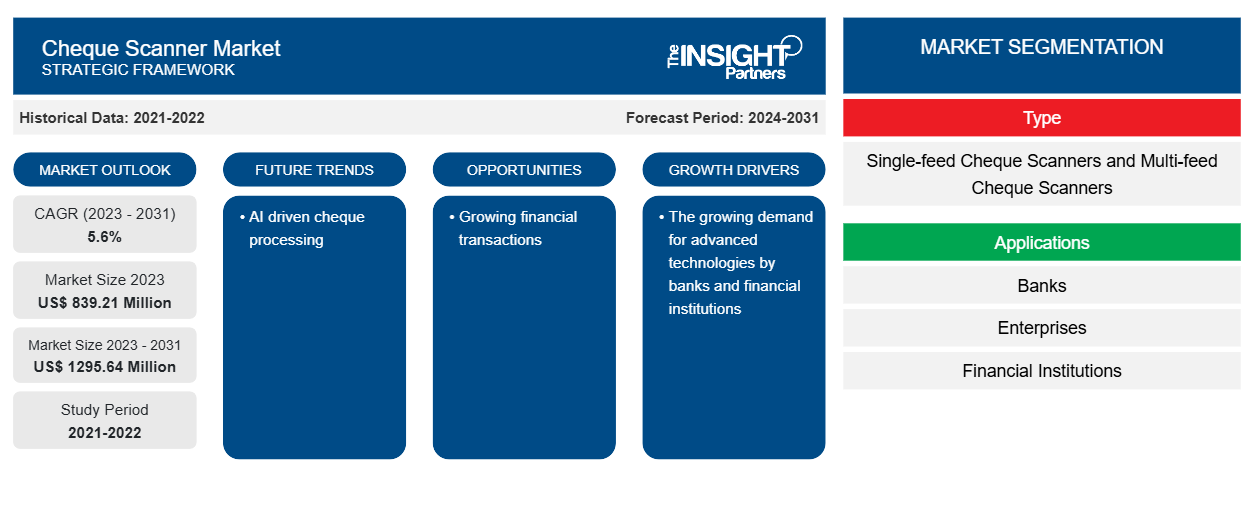支票扫描仪市场规模预计将从 2023 年的 8.3921 亿美元增至 2031 年的 12.9564 亿美元。预计 2023-2031 年期间,该市场的复合年增长率将达到 5.6%。银行和金融机构对先进技术的需求不断增长,以及节省银行运营时间的需求可能仍是市场的主要趋势。
支票扫描仪市场分析
使用支票扫描仪的好处包括节省管理和人工成本、远程支票存款、快速访问数据、提高安全性和提高生产力,这些都推动了银行、企业和金融机构对支票扫描仪的需求。对远程存款捕获 (RDC) 的日益增长的倾向正在推动支票扫描仪市场的发展。
支票扫描仪市场概览
支票扫描仪是一种使用磁性墨水字符识别 (MICR) 技术扫描和读取支票的电子设备。支票扫描仪的开发是为了提高支票处理的效率。支票扫描仪有助于节省时间和金钱。这些扫描仪可以捕捉支票的正面和背面并记录支票的信息,例如银行账户、签名、支票金额等。随着提高工作流程和业务运营效率的需求,对支票扫描仪的需求正在增长。
定制此报告以满足您的需求
您可以免费定制任何报告,包括本报告的部分内容、国家级分析、Excel 数据包,以及为初创企业和大学提供优惠和折扣
-
获取此报告的关键市场趋势。这个免费样品将包括数据分析,从市场趋势到估计和预测。
支票扫描仪市场驱动因素和机遇
银行注重客户满意度
银行高度重视客户满意度,以维护现有客户并吸引新客户。为此,他们采用智能且技术先进的设备来加快银行业务和工作流程,从而导致对支票扫描仪的需求。银行的支票扫描仪可帮助他们提高支票处理操作。扫描仪可以记录支票信息,从而帮助银行维护记录。
金融交易不断增长
随着人口增长和业务增长,金融交易量也在增加。因此,需要高效、准确的支票扫描技术来处理不断增长的支票数量,这导致了对支票扫描仪的需求。这些扫描仪降低了处理支票时出错的风险。它还有助于减少人为错误。它是高容量存款捕获环境的理想解决方案。
支票扫描仪市场报告细分分析
有助于得出支票扫描仪市场分析的关键部分是类型和应用。
- 根据类型,支票扫描仪市场分为单张进纸支票扫描仪和多张进纸支票扫描仪。多张进纸支票扫描仪细分市场预计将以最高的复合年增长率增长。
- 根据应用,市场分为银行、企业和金融机构。银行部门在 2023 年占据了最大的市场份额。
支票扫描仪市场份额(按地区)分析
支票扫描仪市场报告的地理范围主要分为五个地区:北美、亚太、欧洲、中东和非洲、南美和中美。
预计亚太地区将以最高的复合年增长率增长。支票扫描仪可以加快支票处理速度,因此被多家银行和金融机构采用。这些银行和金融机构致力于最大限度地减少欺诈,因此采用了支票扫描仪等技术先进的解决方案。
支票扫描仪市场区域洞察
Insight Partners 的分析师已详尽解释了预测期内影响支票扫描仪市场的区域趋势和因素。本节还讨论了北美、欧洲、亚太地区、中东和非洲以及南美和中美洲的支票扫描仪市场细分和地理位置。

- 获取支票扫描仪市场的区域特定数据
支票扫描仪市场报告范围
| 报告属性 | 细节 |
|---|---|
| 2023 年的市场规模 | 8.3921亿美元 |
| 2031 年市场规模 | 12.9564亿美元 |
| 全球复合年增长率(2023 - 2031) | 5.6% |
| 史料 | 2021-2022 |
| 预测期 | 2024-2031 |
| 涵盖的领域 |
按类型
|
| 覆盖地区和国家 |
北美
|
| 市场领导者和主要公司简介 |
|
支票扫描仪市场参与者密度:了解其对业务动态的影响
支票扫描仪市场正在快速增长,这得益于最终用户需求的不断增长,这些需求源于消费者偏好的不断变化、技术进步以及对产品优势的认识不断提高等因素。随着需求的增加,企业正在扩大其产品范围,进行创新以满足消费者的需求,并利用新兴趋势,从而进一步推动市场增长。
市场参与者密度是指在特定市场或行业内运营的企业或公司的分布情况。它表明在给定市场空间中,相对于其规模或总市场价值,有多少竞争对手(市场参与者)存在。
在支票扫描仪市场运营的主要公司有:
- 帕尼尼公司
- 爱普生公司
- 佳能
- 数字支票
- 麦格泰克
- 阿尔卡
免责声明:上面列出的公司没有按照任何特定顺序排列。

- 获取支票扫描仪市场顶级关键参与者概览
支票扫描仪市场新闻和最新发展
支票扫描仪市场通过收集一手和二手研究后的定性和定量数据进行评估,其中包括重要的公司出版物、协会数据和数据库。以下列出了支票扫描仪市场的一些发展情况:
- Digital Check Corp. 推出了新一代 CheXpress CX35 单张进纸支票扫描仪。CheXpress CX35 是 Digital Check Corp. 专为远程存款捕获 (RDC) 而设计的新一代单张进纸扫描仪。新型号代表了其前身屡获殊荣的 CheXpress CX30 型号的重大现代化。它为有史以来最畅销的单张进纸支票扫描仪添加了几个重要的新功能。(来源:Digital Check Corp,新闻稿,2023 年 10 月)
- 佳能欧洲宣布推出 imageFORMULA R30 文档扫描仪,该扫描仪非常适合家庭办公室和小型企业。该设备设置时间快,用户可在不到 60 秒的时间内即插即用,是追求生产力、便利性和易用性的扫描仪用户的理想选择。(来源:佳能,新闻稿,2023 年 7 月)
支票扫描仪市场报告覆盖范围和交付成果
“支票扫描仪市场规模和预测(2021-2031)”报告对以下领域进行了详细的市场分析:
- 支票扫描仪市场规模及全球、区域和国家层面所有主要细分市场的预测
- 支票扫描仪市场趋势,以及驱动因素、限制因素和关键机遇等市场动态
- 详细的 PEST/波特五力分析和 SWOT 分析
- 支票扫描仪市场分析涵盖主要市场趋势、全球和区域框架、主要参与者、法规和最新市场发展
- 行业格局和竞争分析,涵盖市场集中度、热图分析、知名参与者以及支票扫描仪市场的最新发展
- 详细的公司简介
- 历史分析(2 年)、基准年、预测(7 年)及复合年增长率
- PEST和SWOT分析
- 市场规模、价值/数量 - 全球、区域、国家
- 行业和竞争格局
- Excel 数据集
近期报告
相关报告
客户评价
购买理由
- 明智的决策
- 了解市场动态
- 竞争分析
- 客户洞察
- 市场预测
- 风险规避
- 战略规划
- 投资论证
- 识别新兴市场
- 优化营销策略
- 提升运营效率
- 顺应监管趋势























 获取免费样品 - 支票扫描仪市场
获取免费样品 - 支票扫描仪市场